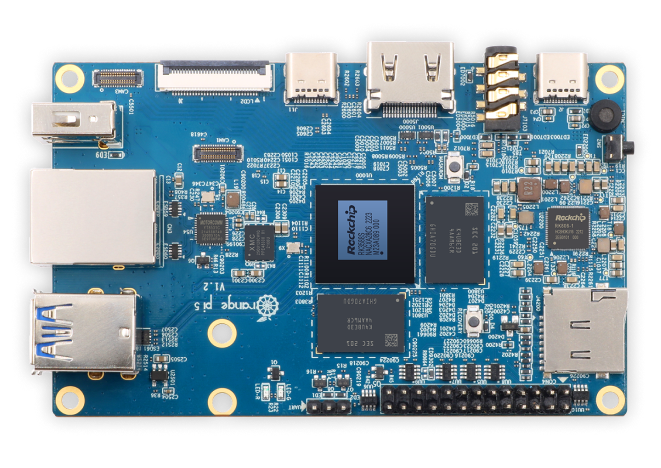
Orange Pi 5: A Powerful and Affordable Single Board Computer
If you are looking for a single board computer (SBC) that can handle various tasks such as edge computing, artificial intelligence, cloud computing, AR/VR, intelligent security, smart home, and more, you might want to check out the Orange Pi 5. This is the latest and most powerful model from Orange Pi, a Chinese company that produces open source hardware and software products based on ARM processors.
The Orange Pi 5 is a SBC that features an 8-core Rockchip RK3588S processor, up to 32GB of RAM, a Mali-G610 GPU, an NPU with up to 6 TOPS, and a 4K/8K video codec. It also provides abundant interfaces, including HDMI output, GPIO interface, M.2 PCIe2.0, Type-C, Gigabit LAN port, USB2.0/3.0, etc. It can run various operating systems, such as Android, Ubuntu, Debian, Armbian, and the official Orange Pi OS (Droid).
How does the Orange Pi 5 compare to the popular Raspberry Pi 4 and other similar SBCs? Is it worth buying? What can you do with it? In this article, we will answer these questions and more. We will cover the hardware, software, applications, and use cases of the Orange Pi 5. We will also provide some examples of projects and tutorials that you can follow to get started with this SBC.
Hardware
The hardware of the Orange Pi 5 is one of its main selling points. It has a powerful processor, a large amount of RAM, a dedicated GPU and NPU, and a variety of interfaces and ports. Let’s take a closer look at each component.
CPU, GPU, NPU, RAM, and Flash
The Orange Pi 5 uses the Rockchip RK3588S, a new generation AIoT chip that uses an 8nm LP process. It has an 8-core 64-bit processor with a Big.Little architecture: four Cortex-A76 cores running at up to 2.4GHz and four Cortex-A55 cores running at up to 1.8GHz. This configuration allows for high performance and low power consumption depending on the workload.
The Rockchip RK3588S also integrates an ARM Mali-G610 MP4 “Odin” GPU, which is compatible with OpenGL ES1.1/2.0/3.2, OpenCL 2.2, and Vulkan 1.2. It has a 3D graphics engine and a 2D graphics engine that can handle complex graphics rendering and image processing tasks.
In addition, the Rockchip RK3588S has a built-in AI accelerator NPU with up to 6 TOPS of computing power. It supports INT4/INT8/INT16 mixed operation, which enables it to perform various AI tasks such as face recognition, object detection, speech recognition, natural
language processing, and more. It also supports various AI frameworks, such as TensorFlow, PyTorch, ONNX, and Caffe.
The Orange Pi 5 comes with two options for RAM and Flash: 8GB LPDDR4X + 128GB eMMC or 32GB LPDDR4X + 256GB eMMC. This gives you plenty of memory and storage space for your applications and data. You can also expand the storage capacity by using a microSD card or an M.2 SSD.
Interfaces and ports
The Orange Pi 5 provides a rich set of interfaces and ports for connecting various peripherals and devices. Here is a list of them:
- HDMI output: Supports up to 8K@60Hz resolution and HDR10+ display. You can connect a monitor, TV, or projector to the Orange Pi 5 and enjoy high-quality video output.
- GPIO interface: Includes 40 pins that support UART, SPI, I2C, PWM, ADC, and other functions. You can connect sensors, actuators, LEDs, buttons, and other modules to the Orange Pi 5 and control them with your code.
- M.2 PCIe2.0: Supports M.2 NVMe SSDs with up to 4TB capacity. You can use this interface to add more storage space or improve the read/write speed of your data.
- Type-C: Supports USB3.0 data transmission, power input/output, and DisplayPort output. You can use this port to charge the Orange Pi 5 or other devices, transfer data, or connect an external display.
- Gigabit LAN port: Supports 10/100/1000Mbps Ethernet network connection. You can use this port to access the internet or a local network with a high-speed and stable connection.
- USB2.0/3.0: Includes two USB2.0 ports and two USB3.0 ports. You can use these ports to connect keyboards, mice, cameras, flash drives, hard drives, and other USB devices to the Orange Pi 5.
- Audio jack: Supports 3.5mm audio output and input. You can use this port to connect headphones, speakers, microphones, or other audio devices to the Orange Pi 5.
- IR receiver: Supports infrared remote control. You can use this feature to control the Orange Pi 5 with an IR remote controller.
- Power button: Allows you to turn on/off the Orange Pi 5 by pressing it.
- Reset button: Allows you to reset the Orange Pi 5 by pressing it.
- Recovery button: Allows you to enter the recovery mode of the Orange Pi 5 by pressing it.
Power source and consumption
The Orange Pi 5 can be powered by either a 12V/2A DC adapter or a Type-C cable. The power consumption of the Orange Pi 5 depends on the workload and the peripherals connected to it. According to some tests, the Orange Pi 5 consumes about 1W in idle mode, 6W in normal mode, and 12W in full load mode.
Dimensions and weight
The Orange Pi 5 has a compact size of 85mm x 56mm x 19mm. It weighs about 50g. It is slightly larger and heavier than the Raspberry Pi 4, which has a size of 88mm x 58mm x 19.5mm and a weight of 46g.
Software
The software of the Orange Pi 5 is another important aspect that determines its functionality and usability. The Orange Pi 5 supports various operating systems and distributions that can run on ARM-based devices. It also has its own official OS called Orange Pi OS (Droid), which is based on Android.
Supported operating systems and distributions
The Orange Pi 5 can run different operating systems and distributions that are compatible with its hardware architecture and specifications. Some of the most popular ones are:
- Android: A mobile operating system developed by Google that is widely used for smartphones, tablets, TVs, smartwatches, and other devices. It offers a user-friendly interface, a privacy protection, anti-theft, firewall, antivirus, etc. You can use the Orange Pi 5 as a smart security device and monitor and protect your home, office, or other places.
- Smart home: The Orange Pi OS (Droid) supports various smart home devices and applications, such as smart speakers, smart lights, smart cameras, smart locks, smart plugs, smart thermostats, etc. You can use the Orange Pi 5 as a smart home hub and control and automate your home appliances and devices.
The Orange Pi OS (Droid) also supports other functions and features of the Orange Pi 5, such as Bluetooth, Wi-Fi, Ethernet, audio, IR, GPIO, etc. You can use these functions and features to connect and communicate with other devices and networks.
How to download and install OS images on Orange Pi 5
If you want to use the Orange Pi OS (Droid) or any other supported operating system on your Orange Pi 5, you need to download and install the corresponding OS image on your device. Here are the steps to do that:
- Download the OS image: You can download the OS image from the official website or from third-party sources. The OS image is usually a compressed file that contains the system files and partitions of the operating system. You need to extract the file to get the image file.
- Prepare a microSD card or an M.2 SSD: You need to use a microSD card or an M.2 SSD as the boot device for your Orange Pi 5. The microSD card should have at least 8GB of capacity and be formatted as FAT32. The M.2 SSD should have at least 128GB of capacity and be formatted as NTFS.
- Write the OS image to the boot device: You need to use a software tool to write the OS image to the boot device. You can use Etcher, Win32 Disk Imager, Rufus, or other similar tools. You need to select the OS image file and the boot device as the source and destination respectively. Then you need to start the writing process and wait until it is finished.
- Insert the boot device into the Orange Pi 5: You need to insert the microSD card into the microSD slot or the M.2 SSD into the M.2 slot of your Orange Pi 5. Make sure that they are properly connected and secured.
- Power on the Orange Pi 5: You need to connect a power source to your Orange Pi 5 via a DC adapter or a Type-C cable. Then you need to press the power button to turn on your device. The Orange Pi 5 will boot from the boot device and load the operating system.
- Set up the operating system: You need to follow the instructions on the screen to set up your operating system. You may need to configure some settings such as language, network, account, etc. After that, you can start using your operating system on your Orange Pi 5.
Applications and use cases
The applications and use cases of the Orange Pi 5 are limited only by your imagination and creativity. You can use this SBC for various purposes such as education, entertainment, development, research, business, etc. Here are some examples of what you can do with it:
What can you do with Orange Pi 5
With Orange Pi 5, you can:
- Learn programming and electronics: You can use Orange Pi 5 as a learning platform for programming and electronics. You can learn various programming languages such as Python, C/C++, Java, etc. You can also learn how to use GPIO interface and various sensors and modules to create interactive projects.
- Build a media center: You can use Orange Pi 5 as a media center for your home entertainment. You can play 4K/8K videos, music, games, etc. on your TV or monitor via HDMI output. You can also stream online content from various platforms such as YouTube, Netflix, Spotify, etc.
- Create a personal cloud server: You can use Orange Pi 5 as a personal cloud server for your data storage and access. You can store your files, photos, documents, videos, etc. on your M.2 SSD or microSD card. You can also access your data from anywhere via the internet or a local network.
- Develop AI applications: You can use Orange Pi 5 as a development platform for AI applications. You can use the NPU to perform various AI tasks with high speed and accuracy. You can also use various AI frameworks and tools to develop your own AI models and applications.
- Make a smart assistant: You can use Orange Pi 5 as a smart assistant for your daily life. You can use the audio jack or a USB microphone to input voice commands and queries. You can also use the IR receiver or a USB remote controller to input other commands. You can use the Orange Pi 5 to control your smart home devices, play music, check weather, news, calendar, etc.
- Explore AR/VR: You can use Orange Pi 5 as an AR/VR device for your immersive experiences. You can use the Type-C port to connect an AR/VR headset and enjoy various AR/VR content and applications. You can also create your own AR/VR content and applications using the Orange Pi 5.
Examples of projects and tutorials using Orange Pi 5
If you want to get some inspiration and guidance for your projects using Orange Pi 5, you can check out some of the following examples and tutorials:
- How to Set Up Orange Pi 5 as a Media Center with Kodi: This tutorial shows you how to install and configure Kodi, a popular media center software, on your Orange Pi 5. You will learn how to add media sources, install add-ons, customize settings, and enjoy various media content on your TV or monitor.
- How to Build a Face Recognition System with Orange Pi 5: This tutorial shows you how to build a face recognition system with Orange Pi 5 using OpenCV, TensorFlow, and FaceNet. You will learn how to capture face images, train a face recognition model, and test the model on real-time video streams.
- How to Create a Personal Cloud Server with Orange Pi 5 and Nextcloud: This tutorial shows you how to create a personal cloud server with Orange Pi 5 and Nextcloud, a popular cloud platform software. You will learn how to install and configure Nextcloud on your Orange Pi 5, and how to access and manage your data from any device.
- How to Make a Smart Assistant with Orange Pi 5 and Google Assistant: This tutorial shows you how to make a smart assistant with Orange Pi 5 and Google Assistant, a popular voice-based virtual assistant service. You will learn how to set up Google Assistant on your Orange Pi 5, and how to use it to control your smart home devices, play music, check weather, news, calendar, etc.
- How to Explore AR/VR with Orange Pi 5 and Oculus Quest 2: This tutorial shows you how to explore AR/VR with Orange Pi 5 and Oculus Quest 2, a popular standalone AR/VR headset. You will learn how to connect your Oculus Quest 2 to your Orange Pi 5 via Type-C cable, and how to enjoy various AR/VR content and applications.
Conclusion
The Orange Pi 5 is a powerful and affordable SBC that can handle various tasks such as edge computing, artificial intelligence, cloud computing, AR/VR, intelligent security, smart home, and more. It has a powerful processor, a large amount of RAM, a dedicated GPU and NPU, and a variety of interfaces and ports. It also supports various operating systems and distributions, including the official Orange Pi OS (Droid), which is based on Android.
If you are interested in buying the Orange Pi 5, you can visit the official website or other online platforms such as AliExpress or Amazon. The price of the Orange Pi 5 is about $99 for the 8GB+128GB version and $149 for the 32GB+256GB version. The price may vary depending on the seller and the shipping cost.
The Orange Pi 5 is a great SBC for anyone who wants to learn programming and electronics, build a media center, develop AI applications, explore AR/VR, or create any other projects that require high performance and functionality. It is also a great SBC for anyone who wants to have a personal cloud server, a smart assistant, a smart security device, or a smart home hub. The Orange Pi 5 can do all these and more with its powerful hardware and software features.
We hope that this article has given you a comprehensive overview of the Orange Pi 5 and its applications and use cases. We also hope that you have found some inspiration and guidance for your own projects using this SBC. If you have any questions or feedback, please feel free to leave a comment below. Thank you for reading!
FAQs
Here are some frequently asked questions and answers about the Orange Pi 5:
- What is the difference between Orange Pi 5 and Orange Pi 4?
- Does the Orange Pi 5 support Wi-Fi and Bluetooth?
- How can I update the operating system of the Orange Pi 5?
- Where can I find more resources and support for the Orange Pi 5?
- What are some alternatives to the Orange Pi 5?
The Orange Pi 5 is the successor of the Orange Pi 4, which was released in 2019. The main difference between them is the processor: the Orange Pi 5 uses the Rockchip RK3588S, while the Orange Pi 4 uses the Rockchip RK3399. The Rockchip RK3588S is more powerful and efficient than the Rockchip RK3399, as it has more cores, higher frequency, smaller process, better GPU, NPU, and video codec. The Orange Pi 5 also has more RAM and Flash options than the Orange Pi 4.
The Orange Pi 5 does not have built-in Wi-Fi and Bluetooth modules. However, you can use an external Wi-Fi or Bluetooth dongle to add these functions to your device. You can plug the dongle into one of the USB ports of the Orange Pi 5 and install the drivers and software accordingly.
You can update the operating system of the Orange Pi 5 by downloading and installing the latest OS image from the official website or from third-party sources. You need to follow the same steps as described in the previous section on how to download and install OS images on Orange Pi 5.
You can find more resources and support for the Orange Pi 5 on the official website, forum, wiki, GitHub, YouTube, Facebook, Twitter, etc. You can also find more resources and support on other websites dedicated to SBCs, such as CNX Software, Hackster.io, Instructables, etc.
If you are looking for some alternatives to the Orange Pi 5, you can check out some of these SBCs: Raspberry Pi 4 Model B, Odroid N2+, Khadas VIM3 Pro, RockPi X Model B+, etc. These SBCs have similar or different features and specifications compared to the Orange Pi 5. You can compare them and choose the one that suits your needs and preferences.
bc1a9a207d

